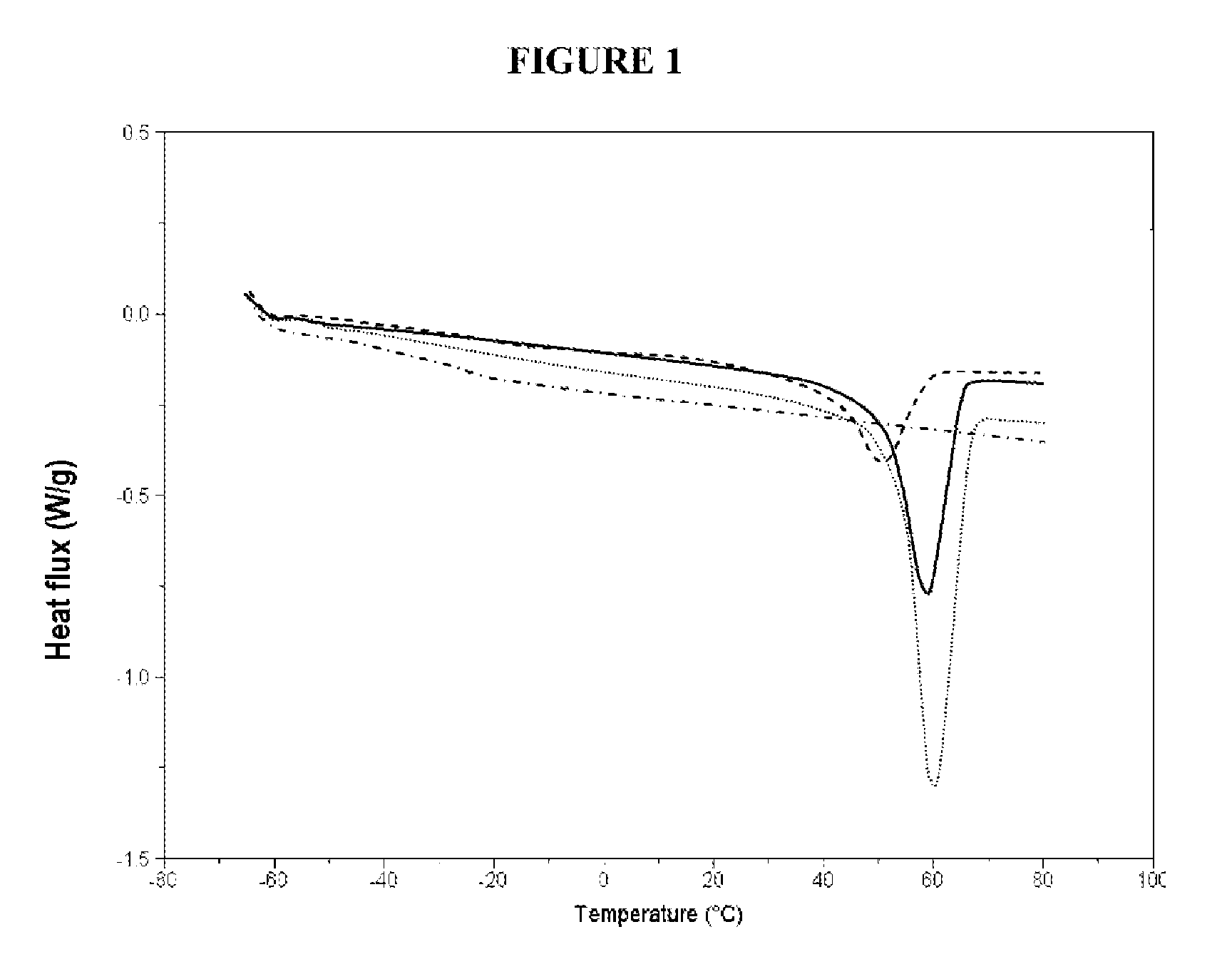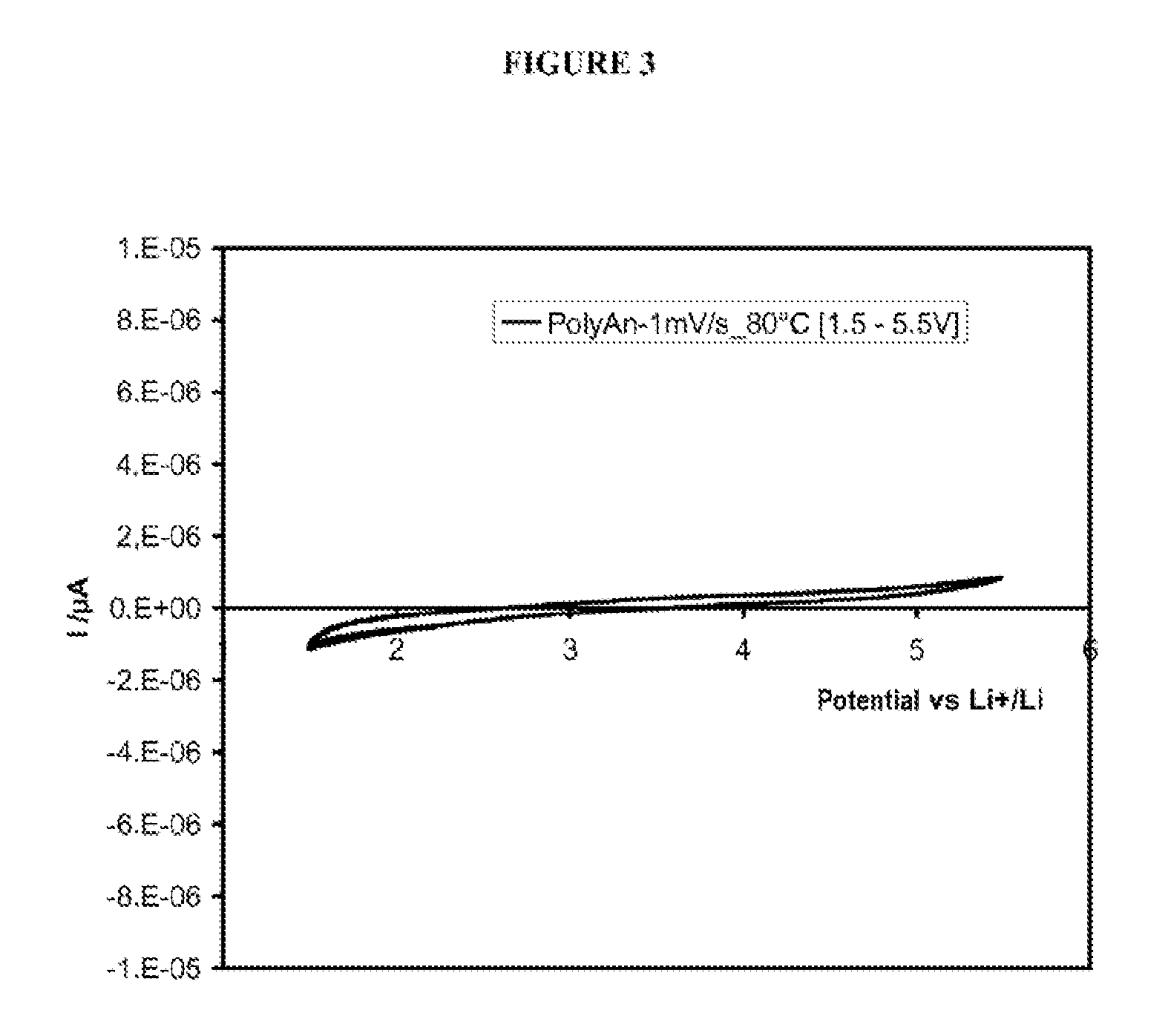Block copolymer including a polyanion based on a TFSILi anion monomer as a battery electrolyte
a polyanion monomer and battery electrolyte technology, applied in the field of block copolymer of the ba or bab type, can solve the problems of inability to develop an electrolyte with both high ionic conductivity and good mechanical durability, polymers with low mechanical strength, and hold back the development of polymer electrolytes, etc., to achieve high lithium ion transfer number, improve ionic conductivity, and good mechanical durability
- Summary
- Abstract
- Description
- Claims
- Application Information
AI Technical Summary
Benefits of technology
Problems solved by technology
Method used
Image
Examples
example 1
Synthesis of Block Copolymers of PSTFSILi-b-PEO-b-PSTKSILi
1) Synthesis of Potassium 4-styrenesulfonyl(trifluoromethylsulfonyl)imide (STFSIK)
[0080]1.1) Synthesis of 4-sulfonyl-styrene Chloride
[0081]2 ml of oxalyl chloride (23.3 mmol) and 0.087 g (1 mmol) of dimethylformamide (DMF) were added to 40 mL of anhydrous acetonitrile. The reaction mixture was stirred for 5 hours to promote the formation of a Vilsmeier-Haack complex (complex between DMF and oxalyl chloride (CH3)2N+=CClH). Once the solution has turned yellow, 4 g of sodium salt of styrenesulfonic acid was slowly added to the reaction mixture, under nitrogen atmosphere and at room temperature. The reaction mixture was then stirred for 24 hours at room temperature. The precipitate of NaCl formed was removed by filtration. 42 mL of solution of 4-sulfonyl-styrene chloride was obtained.
[0082]1H NMR (300 MHz; DMSO-d6; 298 K): δ ppm 7.59 (d, 2H); 7.44 (d, 2H); 6.72 (q, 1H); 5.84 (d, 1H); 5.27 (d, 1H); 5.27 (d, 1H).
[0083]13C NMR (75 M...
example 2
Synthesis of a P(MMATFSILi-stat-PEGA)-b-PEO-b-P(MMATFSILi-stat-PEGA) Block Copolymer
1) Synthesis of Potassium 3-sulfonyl(trifluoromethylsulfonyl)imide Propyl Methacrylate (MMATFSIK)
[0104]This product was synthesized according to the same protocol as potassium 4-styrenesulfonyl(trifluoromethylsulfonyl)imide (STFSIK) using the potassium salt of 3-sulfopropyl methacrylic acid instead of the sodium salt of styrenesulfonic acid. 2.0 mL of oxalyl chloride, 0.087 g of DMF, 40 mL of anhydrous acetonitrile and 5.0 g of the potassium salt of 3-sulfopropyl methacrylic acid were used first; then: 8.1 mL of triethylamine, 2.89 g of trifluoromethylsulfonamide, a catalytic amount of DMAP (about 215 mg) and 30 mL of anhydrous acetonitrile.
[0105]1H NMR (300MHz; DMSO-d6; 298 K): δ ppm 6.04 (s, 1H); 5.67 (m, 1H); 4.17 (t, 2H); 3.06 (m, 2H); 2.01 (m, 2H); 1.88 (s, 3H);
[0106]13C NMR (75 MHz; DMSO-d6; 298 K): δ ppm 166.4 (C═O); 135.7 (C═C); 125.7 (CH2═C); 120.0 (CF3 q); 63.6; 51.2; 23.4; 17.9.
2) Synthesi...
example 3
Investigation of the Physical and Chemical Properties of the PSTFSILi-b-PEO-b-PSTKSILi Block Copolymers Prepared in Example 1
[0110]1) Thermodynamic Properties
[0111]The melting of the PEO crystallites in the various copolymers prepared above in example 1 was studied by differential thermal analysis (DSC: Differential Scanning Calorimetry) using apparatus sold under the reference DSC 2920 by the company Thermal Analysis using an aluminum boat, in the temperature range −70° C. to 80° C. with a heating rate of 5° C. / min (nitrogen flow rate: 10 mL / min).
[0112]The thermograms obtained are presented in the appended FIG. 1, where the heat flux (in W / g) is a function of the temperature. In this figure, the dotted curve corresponds to the copolymer at 9.5 wt % of PSTFSILi, the solid curve corresponds to the copolymer at 21.2 wt % of PSTFSILi, the curve with spaced dashes corresponds to the copolymer at 30.8 wt % of PSTFSILi and the dot-and-dash curve corresponds to the copolymer at 42.9 wt % o...
PUM
| Property | Measurement | Unit |
|---|---|---|
| Temperature | aaaaa | aaaaa |
| Molar mass | aaaaa | aaaaa |
| Molar mass | aaaaa | aaaaa |
Abstract
Description
Claims
Application Information
 Login to View More
Login to View More - R&D
- Intellectual Property
- Life Sciences
- Materials
- Tech Scout
- Unparalleled Data Quality
- Higher Quality Content
- 60% Fewer Hallucinations
Browse by: Latest US Patents, China's latest patents, Technical Efficacy Thesaurus, Application Domain, Technology Topic, Popular Technical Reports.
© 2025 PatSnap. All rights reserved.Legal|Privacy policy|Modern Slavery Act Transparency Statement|Sitemap|About US| Contact US: help@patsnap.com



